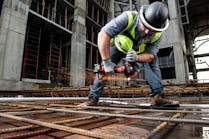Although construction firms expect demand to increase this year, they continue to worry about finding enough workers to meet it. That’s according to respondents in a study by the Associated General Contractors of America and Sage Construction and Real Estate report, “Strong Demand for Work Amid Stronger Demand for Workers: The 2020 Construction Hiring and Business Outlook Report.”
“Contractors are very optimistic about demand for construction in 2020,” said Stephen E. Sandherr, CEO for AGC, in a prepared statement. “At the same time, many construction executives are troubled by labor shortages and the impacts those shortages are having on operations, training and safety programs, and bottom lines.”
The percentage of respondents who expect a market segment to expand exceeds the percentage who expect it to contract for all 13 categories of projects included in the survey. Water & sewer construction scored the highest net positive reading of 25 percent. Segments with a 20 percent net positive included bridge & highway and certain nonresidential markets.
Most contractors plan to add staff in 2020 to keep pace with growing demand, according to the report. Seventy-five percent of firms plan to increase headcount this year, similar to the 77 percent with this expectation at the start of 2019 and 75 percent at the start of 2018. Yet just over half of firms report their expansion plans will only increase the size of their firm by 10 percent or less. About one-fifth of respondents plan to increase headcount by 11 to 25 percent. Only 5 percent of respondents plan to increase employment by more than 25 percent.
Despite firms’ plans to expand headcount, 81 percent report they are having a hard time filling salaried and hourly craft positions. That share is up slightly from 78 percent at the start of 2019. In addition, 43 percent expect it will continue to be hard to hire in the next 12 months and 22 percent expect that it will become harder to hire in 2020.
Firms continue to raise pay and provide bonuses and benefits in response to labor shortages, according to the report. Fifty-four percent of firms report they increased base pay rates more in 2019 than in 2018. Twenty-three percent provided incentives and/or bonuses. Fourteen percent of firms increased contributions or improved employee benefits to cope with workforce shortages.
Construction firms are also investing more in training programs for current and new workers, according to AGC. Two out of five report they revamped initiatives to recruit labor last year. Thirty-two percent of firms report they have increased funding for technical education programs, and 29 percent have restructured or changed programming for current skilled labor recruits.
“Firms are adopting a variety of approaches to replace workers or allow for use of workers with less experience or training than before,” said Ken Simonson, AGC chief economist. He said 32 percent of respondents report their firms are investing in labor-saving equipment, including drones, robots, and 3-D printers. Twenty-eight percent of respondents are using methods to reduce onsite worktime, including lean construction, building information modeling or offsite pre-fabrication.
Nearly half of respondents will increase their information technology (IT) investments in 2020, the report suggests. The largest share of firms, 30 percent, plan to increase their investments in project management software. About a quarter of firms will increase their investments fleet tracking/management software (23 percent).
“We’re seeing an increasing number of firms embrace technology, especially mobile technologies in the field, as a way to help increase efficiencies and achieve business objectives,” said Dustin Anderson, VP of Sage Construction and Real Estate, in a statement. “Technology will continue to play an important role in bridging the gap between growing industry demand, more complex projects, and a less experienced workforce.”





